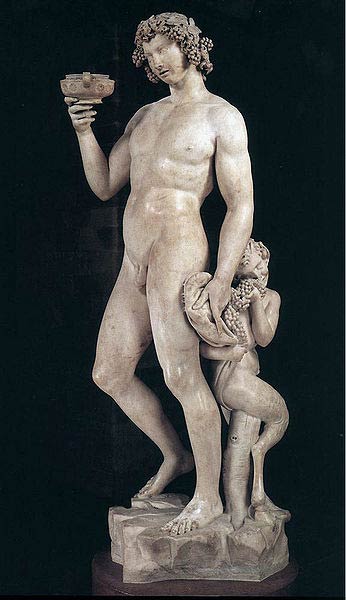| Bacchus | |
|---|---|
 |
|
| Artist | Michelangelo |
| Year | 1496–7 |
| Medium | Marble |
| Location | Museo Nazionale del Bargello, Florence |
| Height | 80 in |
| 203 cm | |
Bacchus is a marble sculpture by the master, Michelangelo, created circa 1496. This statue was originally commissioned by Cardinal Raffaele Riario. However, it was rejected by him and eventually found its way to Jacopo Galli, Cardinal Riario’s banker and a friend of the sculptor, who purchased it in 1506. Some 66 years later it was bought for the Medici and transferred to the royal house in Florence, Italy. Currently it can be viewed at the Museo Nazionale del Bargello in Florence. It is one of just two sculptures surviving Michelangelo’s initial period in Rome, with the other being Pieta.
The Artwork
This somewhat oversized artwork displays a nude Bacchus (the Roman God of wine) posing, holding a goblet of wine in his right hand while clutching the skin of a tiger in his left. Sitting beside him is a faun, seemingly enjoying a bunch of grapes slipping from the Roman God’s grasp. He appears intoxicated with rolling eyes and a slight leaning of the body indicating a lack of balance. His hair is adorned with a wreath of ivy leaves.
This sculpture is normally classified as of the Italian High Renaissance and Baroque era’s.
Meaning
This somewhat effeminate image of Bacchus suggests an androgynous quality that is often associated with the God of wine, madness and ecstasy. The ivy leaves as head wear is indicative of that plants sacredness to God. The tiger skin is often associated with this God for their mutual love of the grape. It is believed to depict a drunken Bacchus. It displays a precarious nature with its high point of gravity also seen in the future works of Michelangelo, including David and the Sistine Chapel ceiling figures.
Many critics have expressed their dislike for the statue as disrespectful to the image of a God. It has been deemed by some as brutal and narrow minded.